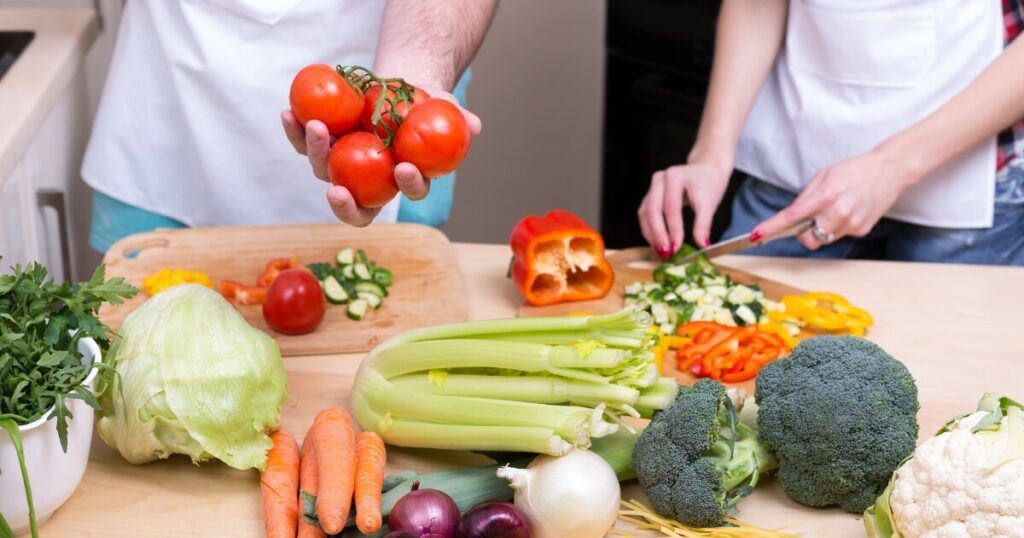From 2008 to 2014, “Our Life In Food” was a beloved food blog. Carrie, Brandon, and Ben created it as a journey of culinary exploration. Their passion for food was evident in the beautiful photographs of their recipes and the engaging narratives that accompanied each recipe. Their innovative approach to cooking won them a loyal following.
Fast forward to 2023, ourlifeinfood.com domain name has officially been acquired by foodmeetsflavor.com, whose focus is on exploring flavors and tastes, helping home cooks elevate their dishes.
Food Meets Flavor is a platform for culinary discovery. We aim to demystify the science of flavors, helping you understand why some recipes might lack the punch you expect. Our mission is to ensure that every meal you prepare is an adventure, a celebration of taste and flavor. Welcome to “Food Meets Flavor” – let’s embark on this delicious journey together!
Taste & Flavor Changes Lives
Taste and flavor are more than just sensory experiences; they are transformative elements that can significantly enhance our lives. The joy of savoring a well-cooked meal, the burst of flavors in our mouth, and the memories evoked by certain tastes – all contribute to our overall enjoyment of food and, by extension, life.

Consider the popular food categories: sweet, salty, sour, bitter, and umami. Each category has its unique appeal and effects.
- Sweet foods, often associated with comfort and celebration, can uplift our mood.
- Salty and umami flavors, found in savory dishes, can satiate our hunger and leave us feeling satisfied.
- Sour and bitter tastes, while sometimes challenging, can add complexity and balance to our meals.
The transformative power of taste and flavor is evident in countless personal stories. Take, for example, a home cook who discovered the joy of cooking during a challenging time, finding solace in the flavors of her childhood recipes.
Or consider a picky eater who, upon trying sushi for the first time, developed a newfound appreciation for seafood and embarked on a journey to explore diverse cuisines.
These stories underscore how taste and flavor can change our lives, opening up new avenues of enjoyment, discovery, and connection.
Why Exploring New Food Options Is Essential
Exploring new food options is an exciting and essential part of the culinary journey. It allows you to expand your palate, discover new cultures, and add variety to your meals. Trying new foods can also help you develop a deeper appreciation for different cuisines and cooking techniques.
Here’s how you can start exploring new food options:
- Visit local farmers’ markets or ethnic grocery stores to find unique ingredients.
- Try a new recipe from a different cuisine each week.
- Join a cooking class or watch online cooking tutorials to learn about different food cultures.
To get you started, check out these unique food options to try:
- Fermented Foods: Foods like kimchi, sauerkraut, and kefir are flavorful and great for gut health. Eat them on their own or place on the side and use them as condiments.
- Jackfruit: A versatile fruit that can be used in both sweet and savory dishes. It’s frequently used as a meat substitute in vegan and vegetarian recipes.
- Gochujang: A Korean red chili paste that adds a sweet and spicy flavor to dishes.
- Black Garlic: This is regular garlic that has been aged under specific conditions until it turns black. The flavor is sweet and tangy, with a hint of balsamic vinegar. It can be used in sauces, rubs, or even desserts.
- Seaweed: Beyond sushi, many types of edible seaweed are rich in nutrients. Try varieties like nori, wakame, or dulse in salads, soups, or even as a snack.
Why Sharing Recipes Is Important
Sharing recipes is a tradition that goes beyond the simple exchange of cooking instructions. It’s a practice that strengthens communities and families, serving as a thread that weaves together generations and cultures.

When families pass down recipes, they’re also passing down a piece of their history and identity. These recipes often tell stories of ancestral homelands, cherished memories, and shared experiences. They become a way to preserve cultural heritage, keeping traditions alive through each delicious dish.
In communities, sharing recipes can create a sense of unity and belonging. Potlucks, community cookouts, and recipe swaps are ways recipe sharing brings people together, fostering connections and friendships.
Moreover, sharing recipes can inspire creativity and innovation in the kitchen. Here’s how:
- It exposes you to different cooking styles and techniques, expanding your culinary repertoire.
- It encourages you to experiment with new ingredients and flavor combinations.
- It challenges you to adapt recipes to your taste, dietary needs, or available ingredients.
In essence, sharing recipes is a way of sharing love, culture, and creativity. It’s a practice that enriches our culinary experiences and brings us closer as a community.
The Art of Creating Flavorful Recipes
Creating flavorful recipes is an art that combines the right ingredients with the right cooking techniques. The ingredients you choose play a crucial role in the overall flavor of your dish. For instance:
- Fresh herbs and spices can add depth and complexity to your dishes.
- Quality proteins, whether meat or plant-based, can significantly enhance the taste.
- Fresh fruits and vegetables add nutrition and contribute to the flavor profile.
However, even the best ingredients can fall flat without the right cooking techniques. Techniques such as searing, roasting, or slow-cooking can enhance the natural flavors of your ingredients. For example, caramelizing onions or browning meat can introduce a whole new level of flavor to your dishes.
Here are some tips for creating flavorful recipes:
- Experiment with different herbs and spices: Don’t be afraid to try new flavor combinations.
- Use cooking techniques that enhance flavor: Searing, roasting, and slow-cooking can bring out the best in your ingredients.
- Taste as you go: Adjust seasonings throughout the cooking process to achieve the perfect balance of flavors.
By understanding the role of ingredients and mastering cooking techniques, you can create recipes that are not just good but truly flavorful.
What To Do When A Recipe Doesn’t Turn Out
Even the most seasoned home cooks have experienced the disappointment of a recipe not turning out as expected. It’s a common part of the cooking journey, and it’s important to remember that each misstep is an opportunity to learn and grow.
There are several common reasons why recipes might fail:
- Misreading or misunderstanding the recipe could include mixing up measurements or skipping a step.
- Substituting ingredients without considering their impact on the recipe: Not all ingredients can be swapped equally.
- Overcooking or undercooking can result from not understanding how your oven or stove works or not checking the food regularly.
If a recipe doesn’t turn out, here are some troubleshooting tips:
- Review the recipe: Check if you missed any steps or misunderstood any instructions.
- Consider your ingredients: Were they fresh? Did you substitute anything?
- Reflect on your technique: Could something have gone wrong during the cooking process?
Remember, a failed recipe is not a failure; it’s a learning opportunity. It’s a chance to improve your cooking understanding and become a more skilled and confident home cook.
So, keep experimenting, learning, and most importantly, enjoying the process.
The Role of Food Blogs in Promoting Taste, Flavor, and Recipe Sharing
Food blogs like “Food Meets Flavor” play a significant role in the food community. They serve as platforms for sharing culinary experiences, promoting the exploration of taste and flavor, and fostering a culture of recipe sharing.
“Food Meets Flavor,” for instance, continues the legacy of “Our Life In Food,” offering a space where home cooks can learn about the nuances of flavor, discover new recipes, and gain insights into the art of cooking. It’s a place where the love for food is celebrated and shared.
Following food blogs can offer numerous benefits:
- Inspiration: Food blogs are a treasure trove of recipe ideas for a quick weeknight dinner or a special holiday dish. You’re sure to find inspiration.
- Education: Many food bloggers share cooking tips and techniques, helping you improve your skills in the kitchen.
- Community: Food blogs often foster a sense of community. You can engage with other readers in the comments, share your cooking experiences, and even contribute your own recipes.
Food blogs are a valuable resource for anyone who loves food and cooking. They enrich our culinary journeys and unite us as a food-loving community.
My Tasty Thoughts
Throughout this article, we’ve explored the transformative power of food, taste, flavor, and recipes. We’ve delved into the science of taste and flavor, the art of creating flavorful recipes, the tradition of sharing recipes, and the importance of exploring new food options.
We’ve also discussed navigating the occasional recipe mishap and the role of food blogs in our culinary journeys.
Food is more than just fuel to keep you going. It’s a source of joy, a means of expression, and a bridge to other cultures. The flavors we savor, the recipes we follow, and the new foods we dare to try all enrich our lives meaningfully.
So, as you continue your cooking journey, remember to explore, experiment, and share. Embrace the adventure of trying new recipes, the satisfaction of mastering a dish, and the joy of sharing your culinary creations with others.
Keep exploring, keep tasting, and keep creating!